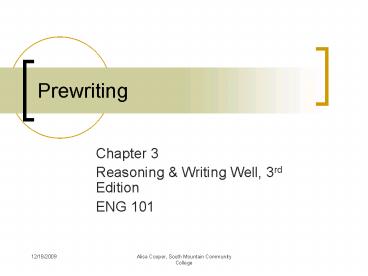Prewriting - PowerPoint PPT Presentation
1 / 14
Title:
Prewriting
Description:
Alisa Cooper, South Mountain Community College. Discovering Ideas ... Alisa Cooper, South Mountain Community College. Full-Fledged Questions. Who was involved? ... – PowerPoint PPT presentation
Number of Views:623
Avg rating:3.0/5.0
Title: Prewriting
1
Prewriting
- Chapter 3
- Reasoning Writing Well, 3rd Edition
- ENG 101
2
Discovering Ideas
- Some students are reluctant to write because they
dont know how to begin. - The prewriting techniques explained in this
chapter can help anyone start writing quickly. - They can also help to divert the flood of anxiety
that sometimes overwhelms writers.
3
Prewriting
- The first stage of the writing process is a time
of discovery you unearth ideas. - Prewriting can condense swirling mists of
thoughts into words on paper. - You uncover raw material to shape and polish
later. - There is no need to think about order or
correctness. - The object is to produce as many ideas as
possible.
4
Prewriting
- You can prewrite whenever and however you like
on paper, at a keyboard, or with a tape recorder. - Most everything we do in class is considered
prewriting. You just have to record it in some
way. - The literature we read, the journalresponses we
write in the discussion board are both prewriting
activities. - The six invention techniques in this chapter are
ways to jump-start ideas.
5
Invention Techniques
- Freewriting
- Clustering
- Brainstorming
- List Making Scratch Outlining
- Questioning
- Reading Literature Doing Research
- Keeping a Journal (Discussion Board or Blog)
6
Freewriting
- Freewriting is uncensored writing, often in
sentence form. - Freewriting enables anyone to start writing
immediately. - To freewrite, just empty whatever bits and pieces
of ideas are in your mind out onto the paper.
7
Clustering
- Clustering is uncensored brainstorming combined
with doodling. - Clustering produces an overview of a subject,
suggests specific topics, and yields related
details. - To begin, take a fresh sheet of paper and write a
general subject in the center. - Circle the word. As new thoughts burst forth, jot
it near the word that prompted it. - Circle the new word. Next, draw a line between
the two. Repeat the procedure.
8
Brainstorming
- Brainstorming captures ideas as they flit by,
either as words, phrases, or fragments. - You can use this technique in a group or alone.
- The secret of success in brainstorming is to
think fast and forgo criticism. - In brainstorming, all ideas are respected and
recorded, no matter how wild.
9
List Making Scratch Outlining on Computer
- List making can be a boon when you know so much
about a topic you feel overwhelmed. - With a list you can narrow a broad range of
possibilities. - Lists often have no apparent order. When you
start placing ideas in order, you are beginning a
scratch outline. - This primitive outline is simply a revised list
that herds ideas into a tentative order.
10
Questioning
- To use questioning at its best, try projecting
yourself into the role of a reporter. - What questions could you ask to elicit
information from other people? - The traditional five Ws and H (who? What?
When? Where? Why? How?) can be expanded to
full-fledged questions
11
Full-Fledged Questions
- Who was involved?
- What happened?
- When did it happen?
- Where did it happen?
- Why did it happen?
- How did it happen?
- What will be its effect?
- What can be learned?
- What is the subject like or unlike?
- How has it changed over time?
12
Reading Literature Doing Research
- You can gather ideas for writing by reading
literature. - We will talk more about this later in the
semester when we read chapters 26, 27, and 28. - This class will also require research.
- We will talk more about this later as well, when
we read chapters 22 23.
13
Keeping a Journal
- Some instructors require that students keep a
journal to store reactions to essays, fiction,
and poetry or other ideas for writing. - We will use the Discussion Board to record some
of our reactions. - Journals are also useful for recording
observations, impressions, and incidents when you
conduct firsthand research.
14
Summary
- Prewriting is a practical way to manage fear of
writing. When a writer faces fear and starts
prewriting, progress begins. - Prewriting is the first stage of the writing
process, an opportunity to discover ideas and
write them down. - Six common invention techniques, useful in
prewriting, are freewriting, clustering,
brainstorming, list-making, scratch outlining,
and questioning. - You may also gather information for writing from
reading literature and doing research. - Journals are a valuable way for storing
observations and ideas for later writing.































